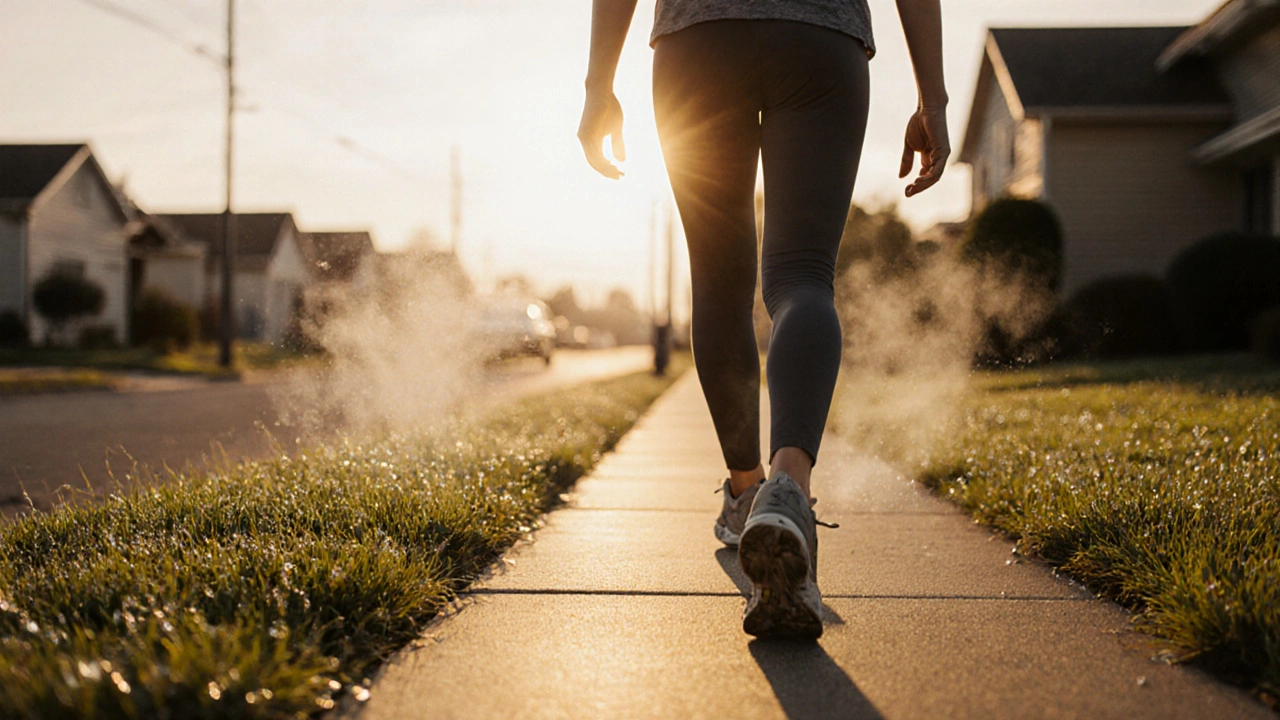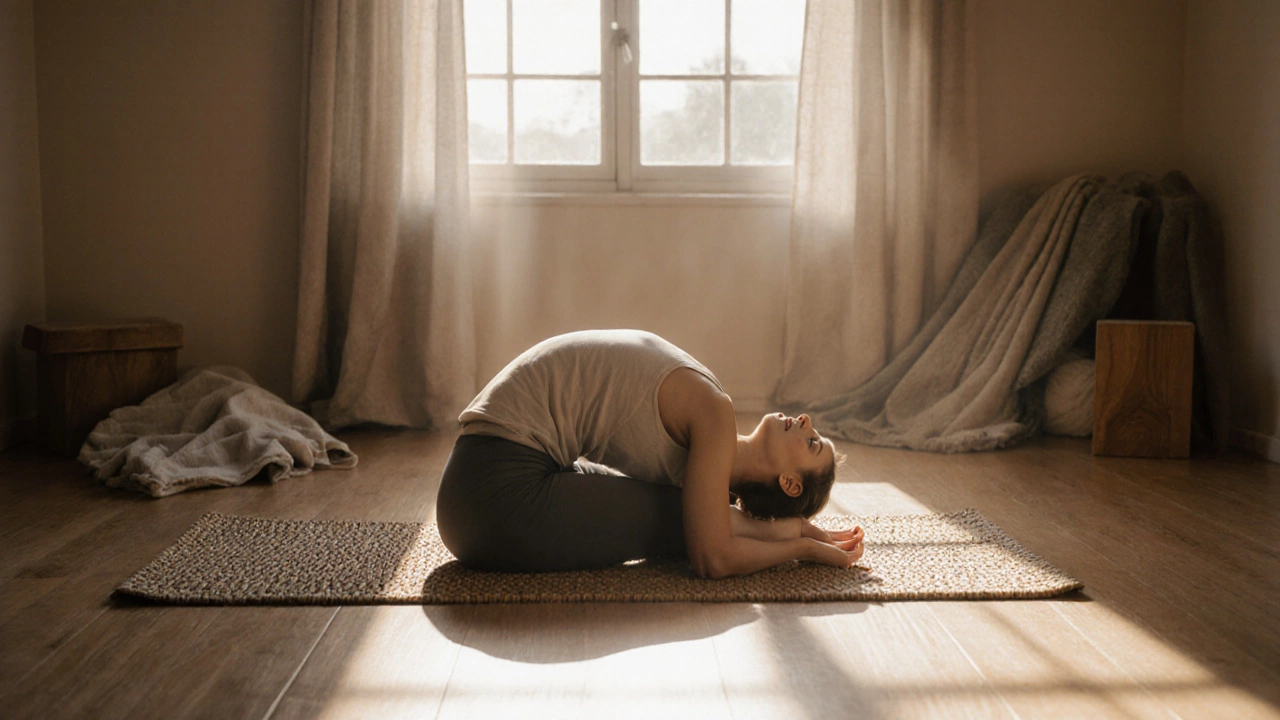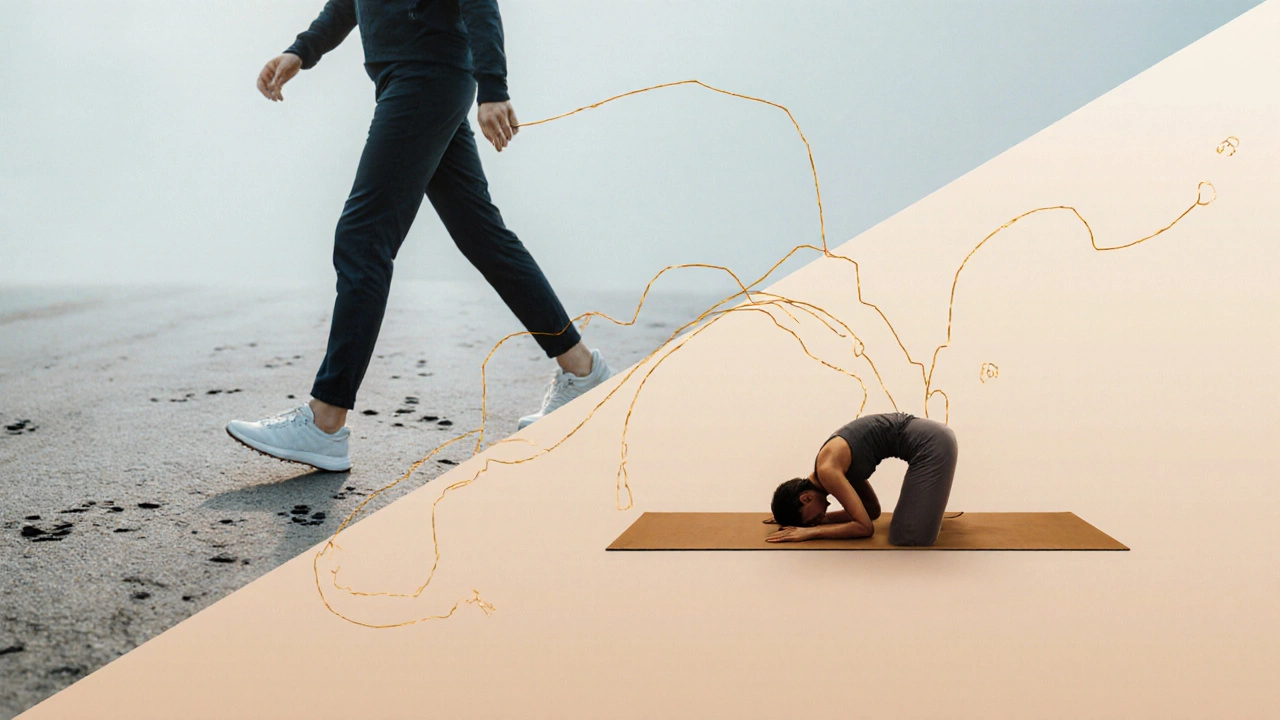
Select your goals and condition to see your personalized routine
Ever stood in your living room at 7 a.m., wondering whether to lace up your sneakers or unroll your yoga mat first? You’re not alone. The order of walking and yoga in your morning routine might seem small, but it can change how your body feels all day. It’s not about which is better overall-it’s about what works for your body right now.
Walking and yoga aren’t interchangeable. One wakes up your cardiovascular system. The other wakes up your nervous system. Doing them in the wrong order can leave you feeling drained, stiff, or even dizzy.
If you start with yoga when your muscles are cold and your blood flow is low, you’re asking your body to stretch deeply without the warmth that comes from movement. That’s like trying to bend a frozen rubber band-possible, but risky. On the other hand, jumping into a brisk walk without any mobility prep can put extra stress on your hips, knees, and lower back.
The key isn’t just activity-it’s preparation.
Walking before yoga is the smarter move if you’re:
A 10- to 15-minute walk at a moderate pace-around 3 to 4 miles per hour-raises your core temperature, gets blood flowing to your muscles, and gently loosens your joints. Your hips open a little. Your spine starts to move. Your breath deepens. That’s the perfect warm-up for yoga.
One 2023 study from the University of Sydney tracked 120 adults doing morning routines for four weeks. Those who walked before yoga reported 37% less muscle soreness and 29% better flexibility during their poses compared to those who started with yoga alone.
Think of walking as the gentle alarm clock for your body. It says, “Hey, we’re waking up. Let’s not jump into headstands yet.”
Yoga before walking is the better choice if you’re:
Yoga first helps quiet your nervous system. If your mind is racing from emails, news, or family chaos, 15 minutes of slow breathing and gentle movement can ground you. That calm carries into your walk, making it more intentional-not just a chore to get through.
Also, if you’re doing a short, mindful walk (20 minutes or less), yoga can serve as your full warm-up. You don’t need to sweat to prepare. You need to connect.
People who start with yoga often report feeling more present during their walk. They notice the breeze, the birds, the rhythm of their steps. That’s not just nice-it’s healing.

Here’s the simple truth: muscles work better when they’re warm. Cold muscles have higher resistance. They’re more prone to micro-tears. They don’t stretch as far.
Walking increases blood flow by 25-40% within just 10 minutes. That means oxygen and nutrients reach your muscles faster. Your synovial fluid-the natural lubricant in your joints-starts moving too. That’s why you can twist into a seated twist more easily after a walk than before.
Yoga, especially dynamic styles like Vinyasa, can also warm you up-but it’s not as reliable for full-body prep. You might open your hips well in pigeon pose, but your hamstrings might still be tight if your heart hasn’t been raised.
That’s why most physical therapists recommend light cardio before stretching. It’s not dogma-it’s physiology.
Some people swear by yoga first, then a long walk. And that’s fine-if it works for them. But here’s the catch: if you do a deep yoga session first, then go for a 30-minute power walk, you might overstretch your ligaments.
Ligaments don’t contract like muscles. Once stretched, they stay that way. Overstretching them repeatedly can lead to joint instability. That’s why yogis with hypermobility are often told to avoid deep stretches without strength training.
Walking after yoga is safe if your yoga session was gentle and you’re not pushing into extreme poses. But if you’ve just held a 5-minute forward fold and then hit the pavement at a fast pace? You’re asking for trouble.
Let’s say you’re a 52-year-old office worker with chronic lower back pain. Your goal is to move better without hurting. Walk first. Ten minutes around the block. Then 20 minutes of yoga focused on cat-cow, child’s pose, and seated spinal twists. You’ll feel looser, steadier, and less achy by noon.
Now imagine you’re a 28-year-old teacher who wakes up anxious. Your mind won’t shut off. Do yoga first. Five minutes of diaphragmatic breathing. Three minutes of legs-up-the-wall. Then walk. Not to burn calories. To feel the sun on your skin. To let your thoughts settle. You’ll show up to class calmer.
There’s no universal rule. There’s only what your body needs today.

Here’s a tested, no-fuss sequence that works for most people:
This routine takes 30-40 minutes. It’s enough to wake you up without exhausting you. It’s enough to make you feel strong, not just stretched.
Don’t lock yourself into one order forever. Your body changes. Your energy changes. Your goals change.
On days you feel sluggish? Walk first.
On days your mind feels loud? Yoga first.
On weekends when you’ve got time? Do both, but listen to your body-not your schedule.
The best routine is the one you stick to. And the one that leaves you feeling more alive, not more tired.
There’s no trophy for doing yoga before walking. There’s no medal for walking faster. There’s only how you feel when you finish-and how you feel an hour later.
Walking burns more calories per minute than yoga, so if weight loss is your main goal, walking first gives you a stronger metabolic kickstart. But yoga helps reduce stress hormones like cortisol, which are linked to belly fat. For best results, do both: walk to burn, then yoga to balance. The combination works better than either alone.
Yes-but be smart. If you have a knee, hip, or lower back injury, walk first at a slow pace to warm up. Then do only gentle, supported yoga poses-no deep twists or forward folds. Avoid anything that causes pain. Use props like blocks or pillows. Listen to your body more than your routine.
It’s fine if your walk was moderate and you’re not exhausted. But if you’ve walked for an hour or more, your muscles are already fatigued. Deep yoga poses might strain them. Stick to restorative poses: legs-up-the-wall, supported bridge, gentle reclining twists. Let yoga be your cooldown, not your workout.
Do yoga first-just 10 minutes of breathing and simple stretches like cat-cow, seated forward fold, and shoulder openers. Then walk for 5 minutes around your yard or hallway. You’ll get mobility and movement without overloading your time. Consistency matters more than duration.
Morning is ideal because your body is stiffest then, and movement helps reset your day. But if you prefer evening, the same rules apply: warm up with walking, then move into yoga. The goal isn’t timing-it’s creating a smooth transition from stillness to motion, and back again.